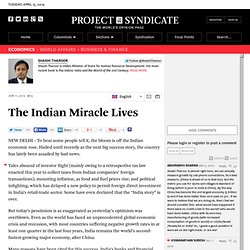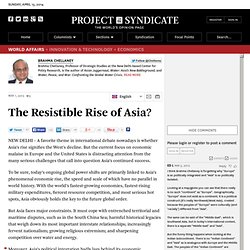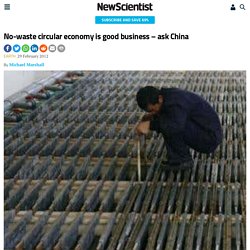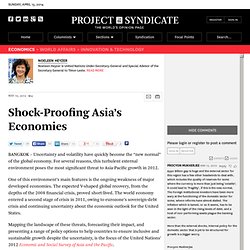

"What Happened to India?" by Raghuram Rajan. "The Indian Miracle Lives" by Shashi Tharoor. Exit from comment view mode.

Click to hide this space NEW DELHI – To hear some people tell it, the bloom is off the Indian economic rose. Hailed until recently as the next big success story, the country has lately been assailed by bad news. "The Resistible Rise of Asia?" by Brahma Chellaney. Exit from comment view mode.

Click to hide this space NEW DELHI – A favorite theme in international debate nowadays is whether Asia’s rise signifies the West’s decline. But the current focus on economic malaise in Europe and the United States is distracting attention from the many serious challenges that call into question Asia’s continued success.
To be sure, today’s ongoing global power shifts are primarily linked to Asia’s phenomenal economic rise, the speed and scale of which have no parallel in world history. With the world’s fastest-growing economies, fastest-rising military expenditures, fiercest resource competition, and most serious hot spots, Asia obviously holds the key to the future global order. But Asia faces major constraints. Moreover, Asia’s political integration badly lags behind its economic integration, and, to compound matters, it has no security framework.
So make no mistake. Insight: Japan slowly wakes up to doomsday debt risk. No-waste circular economy is good business – ask China - environment - 29 February 2012. By Michael Marshall Don’t throw out that broken toaster: it’s key to our prosperity.

Redesigning the economy so that all waste is reused or recycled would be good for business, according to two new reports. For centuries the global economy has been linear. Companies extract resources from the environment, turn them into products and sell them to consumers – who eventually throw them out. As a result we are burning through Earth’s natural resources and wasting useful materials. But it doesn’t have to be that way, says Felix Preston of think tank Chatham House in London.
In “A Global Redesign: Shaping the circular economy”, Preston argues that reusing resources makes good business sense now that resource prices are high and volatile. “Towards the Circular Economy: Economic and business rationale for an accelerated transition” estimates the circular economy could save the European Union $340 to $630 billion per year in materials costs, about 3 per cent of the EU’s GDP.
More on these topics: Why Burma Shouldn’t Listen to the IMF - By Rick Rowden. Burma is at a crossroads.

While the country's dramatic (and fragile) political opening is receiving plenty of attention, its leaders are also confronting some stark decisions about their economic future. After decades of economic isolation, the economy of Burma (also known as Myanmar) is badly in need of reforms than can better promote development. The choices that Burma's government makes in the coming months could well determine what the country will look like 30 years from now: an industrialized South Korea or a resource-cursed Nigeria. Coinciding with its political opening, Burma's leadership has taken steps to deepen the pool of foreign investors in the economy beyond the traditional influence of neighbors China and Thailand. The IMF has already sent several delegations to the country and is assisting the government in unifying its complex system of multiple exchange rates for the currency, the kyat, as a necessary first step to other reforms.
SOE THAN WIN / AFP / Getty Images. "Shock-Proofing Asia’s Economies" by Noeleen Heyzer. Exit from comment view mode.

Click to hide this space BANGKOK – Uncertainty and volatility have quickly become the “new normal” of the global economy. For several reasons, this turbulent external environment poses the most significant threat to Asia-Pacific growth in 2012. One of this environment’s main features is the ongoing weakness of major developed economies. The expected V-shaped global recovery, from the depths of the 2008 financial crisis, proved short-lived. Mapping the landscape of these threats, forecasting their impact, and presenting a range of policy options to help countries to ensure inclusive and sustainable growth despite the uncertainty, is the focus of the United Nations’ 2012 Economic and Social Survey of Asia and the Pacific.
Our forecast is that persistent headwinds will slow Asia-Pacific economic growth to 6.5% this year, down from 7% in 2011. "Asia Exposed" by Stephen S. Roach. Exit from comment view mode.

Click to hide this space NEW HAVEN – Asian authorities were understandably smug in the aftermath of the financial crisis of 2008-2009. Growth in the region slowed sharply, as might be expected of export-led economies confronted with the sharpest collapse in global trade since the 1930’s.